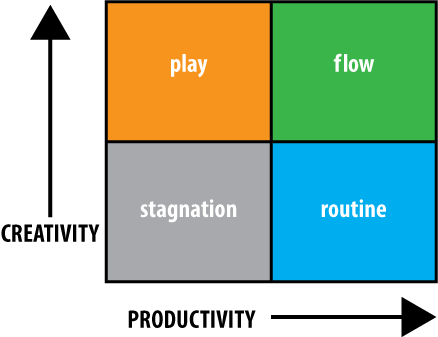Creating something seems synonymous to producing something. Yet, the terms creativity and productivity can be very different concepts. If I describe someone as “creative” you probably imagine an artist or a person who generates clever ideas. When I mention a “productive” person, you likely think of someone very different. Perhaps an assembly line worker cranking out widgets, or a paper pusher who can empty their inbox at lightning speed.
The truth is you need to be both of these people. You need to be productive so you can meet deadlines and help your business be profitable. Meanwhile, you also need to be creative in order to generate new ideas, come up with better ways to do your work or find innovative solutions when things don’t go as planned. In the middle of the daily grind, you probably don’t think much about bringing the proper mix of creativity and productivity to your work.
But what is the proper mix of creativity and productivity? Here are 3 signs they are out of balance and how to balance your creativity and productivity.
-
Too Much Play: Resistance pushes you to the next idea.
An idea energizes and motivates you. You organize and rally behind it until you start to feel resistance. Energy wains as you realize the challenges of executing your idea. Eventually, you are lured away by another (newer, shinier) idea and the cycle starts over. Constantly chasing new ideas never allows the previous ones to mature.
In her book Multipliers, Liz Wiseman describes this syndrome:
Idea Guys are fountains of creativity, and their minds race with non-stop ideas. They may think they’re sparking innovation, but they cause whiplash as people scurry to keep up with each new idea, making minor progress in many directions.
Signs you are too heavily in the “play” quadrant:
- You never document processes for your activities because they change so often.
- You are stretched in many directions, but don’t seem to complete many tasks.
- You spend a heavy amount of time planning and brainstorming, but lose interest when it’s time to execute.
How to restore balance:
- Put new ideas in a “parking lot.” Write them on a dry erase board or add them to a list on your computer. Revisit them after the initial euphoria has worn off to see if they still have merit.
- Start with the end in mind. Use the initial energy at the beginning of a project to set up milestones. Envision what success will look like and predict how completing the effort will make new opportunities available. This will help you push through the valleys of the project.
- Use new ideas as motivators to finish your current work. There is an opportunity cost to saying “yes” to new ideas because they can take away from what you’re currently working on. Don’t allow yourself to start working on a new idea until you complete something comparable.
-
Too Much Routine: Each day looks like the one before.
You’re so busy executing, you don’t have time to question why you’re doing what you’re doing, let alone if there could be a better way to do it. Established ideas are not challenged and new ideas are not offered up. Because of this, each day seems like you just go through the motions. You stack ’em up, knock ’em down, then stack ’em up again.
Signs you are too heavily in the “Routine” quadrant:
- “That’s the way we’ve always done it.” is a common refrain. New team members or business partners are the only ones who offer ideas, and even that is temporary.
- You’re losing market share to competitors who are more innovative. You keep old-fashioned customers only because of their sense of comfort and loyalty (until it gets too painful for even them).
- Roles never seem to change. If you have a team, there’s no sign of advancement opportunities.
How to restore balance:
- Have more patience with alternatives offered by others. Allow ideas to incubate before shooting them down. (See 10 Signs You’re Shooting Down Good Ideas)
- Be willing to test new ideas. If you’re scared to put a huge investment into a new product or service, see what you can do to float a trial balloon. Can you create a prototype or beta test with a select group?
- Shake up routines. Ask team members if they want to do something different or try on a new role. Visit a museum or attend a conference. Visit the bookstore and select a few magazines from other industries, then identify trends and see if you can apply some of them to your business.
-
Welcome to the morgue: Stagnation
This is the most dangerous quadrant. You’re not creative and you’re not productive. You’ve practically flatlined. This can happen because of burnout or setbacks, but basically what you’ve been doing no longer works and you’ve now lost all motivation to try anything new.
Signs you’re in stagnation.
- It smells like entropy. Without any energy being injected into your business, things have trended toward chaos. Things aren’t well organized nor are they updated. Maintenance is slipping, perhaps non-existent, and appearances have not been kept up. (see The Smell of Entropy for an example)
- It sounds like apathy. Common phrases are “Who cares?”, “It’s not worth the effort.” or “Nothing’s going to change anyway.”
- It feels like death. You’ve gone through the stages 1) Denial and Isolation, 2) Anger, 3) Bargaining, 4) Depression and 5) Acceptance. Now all that’s left is to wait for the bank to put the last nail in the coffin.
How to restore balance:
In his book, Boundaries for Leaders, Dr. Henry Cloud talks about how to reverse the death spiral of a leader. His points give a good framework for escaping stagnation
- Create connections. Schedule times to bring your team together and let everyone discuss the current situation and even share some potential solutions. Emphasize a positive tone, but encourage honesty. Share in victories and difficulties.
- Regain control. Dr. Cloud recommends making a list of things you can’t control that are making business difficult. Spend 5-10 minutes REALLY worrying about them (don’t be in denial). Then stop worrying about them. Make another list of what you can control which can create positive results. Prioritize this list and plan these activities as your primary focus.
- Take note of the 3 P’s. Realize it’s not Personal (you are not a failure). It’s not Pervasive (not everything is going wrong). It’s not Permanent (don’t lose hope). Dr. Cloud recommends journaling the negative thoughts around the 3 P’s and writing counterarguments to each.
- Add structure and accountability. Break your workday down into small increments (e.g. 30 minutes each), and specifically plan what to do in that time. “[Writing down objectives] for each thirty minutes of the day helps identify and isolate activities that are particularly endangered due to inaction.”
- Take the Right Kind of Action with the Right Kind of Accountability. Take action that SPECIFICALLY drives results. Dr. Cloud further states, “The accountability you want is the kind that drives success, not the kind that only measures results and keeps score.” and “Said another way, don’t count the score. Count the behaviors that run up the score.”
At the beginning of this article, I mentioned how creativity and productivity differ. By taking stock of where you are in the grid above, then restoring the balance of creativity and productivity in your business and/or team, you’ll likely discover these two words come together to create a state of flow. This is where creativity and productivity work together, building upon each other in a powerful way. When you’re in a state of flow, ideas help drive activities to completion while measurable progress promotes innovation and inspiration.
We need both creativity and productivity to accomplish meaningful work on a consistent basis. Finding this balance may be the difference in discovering your success.
If you have thoughts on creativity and productivity, feel free to leave a comment below or tweet me about it.


